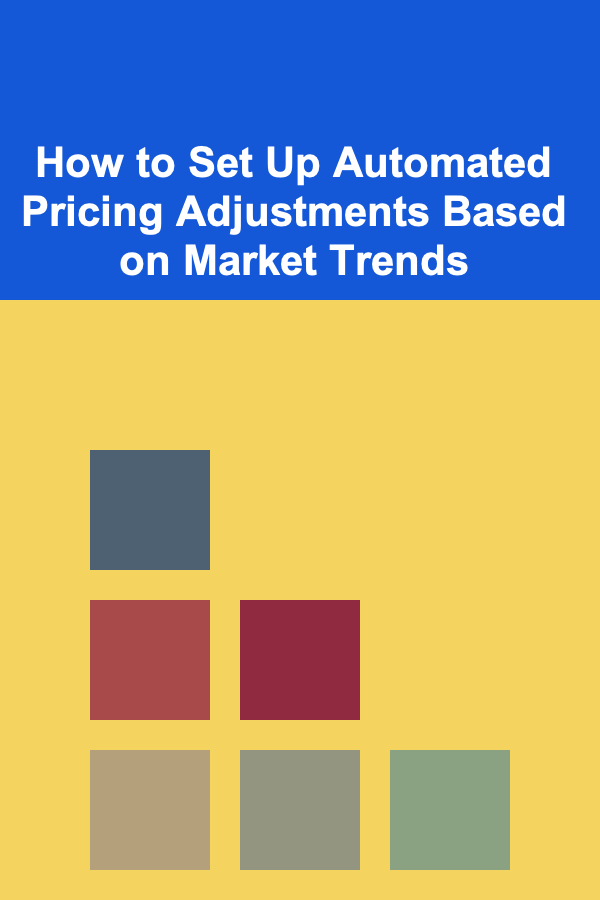
How to Set Up Automated Pricing Adjustments Based on Market Trends
ebook include PDF & Audio bundle (Micro Guide)
$12.99$8.99
Limited Time Offer! Order within the next:

In today's fast-paced and ever-changing marketplace, businesses must be agile to stay competitive. One of the most effective ways to achieve this is through automated pricing adjustments based on real-time market trends. By implementing an automated pricing strategy, businesses can ensure their prices remain competitive, optimize revenue, and respond quickly to market fluctuations.
This actionable guide will take you through the steps involved in setting up automated pricing adjustments, from understanding market trends to implementing the right tools and strategies for success.
Understand Market Trends and Their Impact on Pricing
Before you dive into setting up an automated pricing system, it's crucial to understand the different market trends that influence pricing decisions. These trends can range from changes in supply and demand, shifts in consumer behavior, competitor pricing strategies, seasonal variations, to broader economic factors.
Key Market Trends to Monitor:
- Demand Fluctuations: When demand for a product or service rises, prices typically increase, and vice versa. Understanding seasonal demand patterns and using tools that track these fluctuations will help you adjust your pricing accordingly.
- Competitor Pricing: Your competitors' pricing can have a significant impact on your own pricing strategy. If they lower their prices, it might force you to follow suit or risk losing market share. Conversely, if they raise their prices, it may provide an opportunity for you to capture more customers.
- Consumer Behavior: Market trends also include shifts in consumer preferences. If there's a growing interest in eco-friendly products or a specific feature, adjusting your pricing based on these consumer demands can help you capture a niche market.
- Economic Factors: Inflation, currency exchange rates, or changes in tariffs can impact the cost of goods and services. Keeping an eye on these macroeconomic trends is essential for setting prices that protect your margins.
Choose the Right Data Sources for Real-Time Market Insights
Automated pricing relies heavily on data. The quality and timeliness of the data you use will directly affect the accuracy and effectiveness of your price adjustments. Here's how you can gather and leverage data for real-time market insights:
Key Data Sources for Pricing Adjustments:
- Competitor Price Monitoring Tools: There are many tools available that track competitor prices automatically. These tools analyze competitor websites and give you insights into their pricing strategies. Some popular tools include Price2Spy, Prisync, and Competera.
- Sales Data and Analytics: Your own sales history is one of the best indicators of market trends. Analyzing sales data helps you understand customer preferences and demand cycles, which can influence pricing adjustments.
- Customer Behavior Data: Using web analytics and consumer insights tools (such as Google Analytics, Hotjar, or Mixpanel), you can identify purchasing behaviors, which products are most in demand, and when people are likely to make a purchase. This data can help you optimize pricing based on actual demand patterns.
- Market Research and Surveys: Regular market research through customer surveys or industry reports gives you qualitative and quantitative insights into consumer price sensitivity, preferences, and perceptions of value.
- Economic Data: Pay attention to external economic indicators like inflation rates, interest rates, and currency fluctuations. For instance, when inflation rises, customers may expect price increases, or conversely, if currency devalues, you may need to adjust pricing to maintain profitability.
Define Your Pricing Strategy
Your pricing strategy is the foundation for automated pricing adjustments. It's important to first decide on the overarching goals of your pricing, as it will guide how your automated system behaves.
Common Pricing Strategies:
- Dynamic Pricing: Dynamic pricing is based on the concept of adjusting prices in real-time depending on market conditions. This is ideal for industries where prices change frequently, such as travel, hospitality, or e-commerce.
- Cost-Plus Pricing: This strategy involves setting a price based on the cost of the product or service plus a fixed markup. While not always the most flexible, it's a straightforward approach that can still benefit from automated adjustments in the face of changing costs (e.g., raw material costs).
- Penetration Pricing: If you're entering a new market, penetration pricing involves setting lower prices initially to attract customers, with the intent of raising them once you've gained market share.
- Price Skimming: This strategy sets high prices initially for premium products and gradually lowers them over time as the market becomes saturated or demand declines.
Once you've selected your pricing strategy, it's essential to set parameters for how your pricing should adjust based on certain triggers, such as price elasticity, competitor pricing changes, or market demand shifts.
Choose the Right Automated Pricing Software
The next step is to select a pricing automation tool that suits your business's needs. Automated pricing software can analyze data, make adjustments in real-time, and ensure that your prices stay competitive.
Here are some features to look for when choosing pricing software:
- Real-Time Data Integration: Your software should integrate with data sources such as competitor prices, sales data, and market trends in real-time to make quick and accurate pricing adjustments.
- Customizable Rules and Algorithms: The ability to set your own rules for price adjustments is essential. For example, you might set a rule that your prices should be 5% lower than a competitor's price or adjust based on inventory levels.
- Price Optimization Algorithms: A good pricing tool will use machine learning algorithms to analyze vast amounts of data and predict the optimal price for your products based on various factors, including competitor prices, demand trends, and historical sales data.
- Forecasting and Predictive Analytics: Some pricing software includes predictive analytics, which can forecast future market trends and adjust your prices accordingly. This is especially useful for setting long-term strategies and preparing for upcoming market shifts.
Popular pricing automation tools include:
- Dynamic Pricing Tools: Pricemoov, Omnia Retail, and Wiser are great for businesses in highly competitive markets where prices need to be adjusted frequently.
- E-commerce Specific Tools: For e-commerce businesses, solutions like Shopify's Dynamic Pricing, RepricerExpress, and SellerActive provide tailored features for adjusting prices on platforms like Amazon and eBay.
Set Pricing Adjustment Rules and Triggers
Once you've chosen the right software, it's time to define the pricing rules that will guide your automated pricing system. These rules dictate how and when your prices will change based on market trends.
Pricing Adjustment Triggers:
- Competitor Price Changes: Set rules that trigger price changes when a competitor alters their pricing. For example, if a competitor lowers their price, your system could automatically lower yours to match or stay competitive.
- Demand Fluctuations: Use sales data and consumer behavior insights to adjust your prices according to demand. For example, if a product sees a spike in demand, your system could raise the price to capitalize on the increased interest.
- Inventory Levels: If stock levels are low, your system might automatically increase prices to reflect the scarcity of the product. Alternatively, when inventory is high, you might lower prices to clear excess stock.
- Seasonal Trends: Some automated pricing systems allow you to set rules based on seasons or holidays. For instance, during peak shopping seasons like Christmas or Black Friday, prices can be adjusted to maximize revenue.
- Market Conditions: As mentioned earlier, economic factors like inflation or currency fluctuations can impact your pricing decisions. You can set up automatic adjustments that are triggered by certain economic conditions, such as a rise in raw material costs or changes in tariffs.
Monitor and Refine Your Pricing Strategy
Implementing automated pricing is not a "set it and forget it" process. It's important to continually monitor the effectiveness of your pricing adjustments and make refinements as needed.
Continuous Monitoring:
- Track Performance Metrics: Monitor key metrics such as sales volume, profit margins, and customer feedback to gauge how your automated pricing system is performing. If prices are too high or too low, adjustments might need to be made.
- Test and A/B Compare: Use A/B testing to compare different pricing strategies and determine which one delivers the best results. For example, you might test different price points to see which maximizes revenue without hurting customer acquisition.
- Fine-Tune Algorithms: Machine learning and predictive analytics algorithms improve over time as they process more data. Regularly reviewing and updating your system ensures it remains effective as market conditions evolve.
Ensure Legal and Ethical Compliance
While automated pricing offers immense benefits, it's essential to ensure that your pricing practices comply with relevant regulations and ethical standards. Automated price-fixing (collusion between competitors) and other anti-competitive practices are illegal and can result in significant fines or legal issues.
Before setting up your automated pricing system, familiarize yourself with:
- Price Discrimination Laws: Ensure that your pricing doesn't unfairly discriminate against certain customer segments.
- Competition Laws: Be mindful of antitrust laws that prevent unfair price manipulation or collusion.
Conclusion
Automated pricing adjustments based on market trends are essential for businesses seeking to stay competitive and optimize their revenue in an ever-changing market landscape. By understanding market trends, gathering real-time data, choosing the right pricing strategy and tools, and continuously monitoring the system's performance, you can successfully implement a dynamic and profitable pricing model. Automation allows you to respond quickly to market changes, reduce the time spent on manual adjustments, and ensure that your prices are always aligned with current market conditions.
Reading More From Our Other Websites
- [Organization Tip 101] How to Create a Pantry Inventory Rotation Schedule
- [Personal Care Tips 101] How to Apply Antiperspirant Properly for Maximum Effect
- [Home Party Planning 101] How to Plan a Romantic Dinner Party for Two at Home
- [Polymer Clay Modeling Tip 101] How to Use Polymer Clay to Replicate Vintage Metal Patinas on Tiny Sculptures
- [Personal Financial Planning 101] How to Master Managing Your Cash Flow for a Stress-Free Financial Life
- [Sewing Tip 101] How to Perfect the French Seam for Ultra‑Delicate Sheer Fabrics
- [Home Pet Care 101] How to Prevent Pets from Getting into Toxic Household Items
- [Organization Tip 101] How to Simplify Your Daily Routine for Less Clutter
- [Organization Tip 101] How to Create a Personalized Home Office Setup
- [Home Pet Care 101] How to Create Pet-Safe Holiday Decorations That Add Festive Cheer Without Posing Risks to Your Pets

How to Use Curtains and Blinds to Minimize Noise
Read More
The Brand Manager's Playbook: Essential Tactics for Brand Positioning and Success
Read More
How To Capture Stunning Interviews on Video
Read More
Mastering the Stand Mixer: Perfect Dough and Batters
Read More
Feng Shui Colors: Choosing Hues for Different Energies
Read More
How to Analyze DNA Sequences for Beginners
Read MoreOther Products

How to Use Curtains and Blinds to Minimize Noise
Read More
The Brand Manager's Playbook: Essential Tactics for Brand Positioning and Success
Read More
How To Capture Stunning Interviews on Video
Read More
Mastering the Stand Mixer: Perfect Dough and Batters
Read More
Feng Shui Colors: Choosing Hues for Different Energies
Read More